Michael Dweck
| Michael Dweck | |
|---|---|
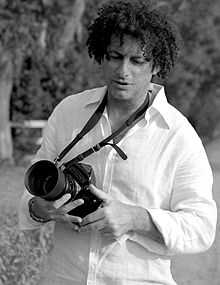 | |
| Born |
September 26, 1957 Brooklyn, New York, U.S. |
| Nationality | American |
| Known for | Fine art photography, Filmmaking |
| Website | |
|
michaeldweck | |
Michael Dweck (born September 26, 1957) is an American visual artist and filmmaker known for his suggestive photographic style.[1] The concept of beauty and its aesthetics are important themes in his work and are explored through both figurative and abstract means. In 2003, he became the first living photographer to have a solo show at Sotheby's in New York.[2][3][4] He lives and works in New York City and in Montauk, New York.
The New York hamlet of Montauk, located at the far eastern tip of Long Island, played a formative role in Dweck's work and was the subject of his first major exhibition and book, The End: Montauk, N.Y. Dweck discovered the community in the 1970s and was inspired by its surfer culture.[5]
Early life and education
Dweck was born in Brooklyn to David and Sydelle Dweck. He was raised in Bellmore, New York, a town on Long Island about 27 miles east of Manhattan and close to many beaches.[1] He credits his early interest in the water to fishing trips he took with his father as a child, and started taking pictures on Jones Beach in the 1970s.[6]
Dweck graduated from Bellmore's John F. Kennedy High School in 1975.[1] He attended Pratt Institute in Brooklyn, first as an architecture student, then switching to communication and fine arts in 1976. After graduating in 1979, he went on to study with artist James Wines and with semiotician Marshall Blonsky at The New School for Social Research.[1][7]
Dweck & Campbell
In 1993, Dweck founded the advertising agency Dweck & Campbell with Lori Campbell. In a 1998 interview with CNN Money, Dweck was quoted as saying "Advertising is the quintessential sitcom. The love affairs with clients, the breakups, the coming back together again and, of course, the constant reruns."[8] A highlight for the firm in 1998 was its Dial-a-Mattress television commercial featuring an angry, man-sized squirrel who wants to hibernate for the winter. The ad, noted for its comic abrasiveness, was pulled from the airwaves after only 13 days.[9] It then went on to win a coveted Gold Lion award at the Cannes International Advertising Festival, and was selected for inclusion in both the Gale Group's 100 most influential marketing campaigns of the year and Boards magazine's Top 10 Boards awards of 1999.[10][11][12]
After the agency won the American Association of Advertising Agencies 1999 award for small agencies, Campbell departed the firm, and it was renamed Dweck, Inc.[13][14] The firm continued with its "usual creative mischief", doubling its previous year's billings to $50 million.[9]
In 2001, Dweck closed his company and left advertising to concentrate on photography. He was quoted in The New York Times as saying he wanted to "concentrate on what I love, which is creative development."[15]
Visual artist
| “ | There are no rules in Montauk. There are no traffic lights, and even the policemen are surfers. Your good looks are your currency in this community. | ” |
| —Michael Dweck, Esquire UK, June 2004 | ||
In 2002, Dweck began to focus his efforts towards his work in the visual arts. He has expressed his preference for being called a visual artist rather than a photographer, saying "We're entering a time when people think downloading Instagram on your iPhone makes you a photographer, and I think it's important that any true photographer, one who has heart and vision, distances himself or herself from that."[16]
The End: Montauk, N.Y.
After closing his advertising agency, in 2002 Dweck began to photograph subjects and scenes around Montauk, focusing on its surfing subculture. The photos evoked "the paradise of summer, youth, and erotic possibility, and of community and camaraderie in a perfect setting."[17] The work is a blend of nostalgia, documentary, and fantasy.
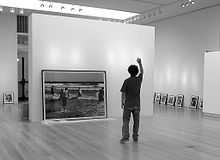

Dweck would parlay this collection of art photos into the 2003 solo show at Sotheby's in New York and in 2004 his first book, The End: Montauk, N.Y., published by Harry N. Abrams.[18] The 5,000-print run was sold out in less than three weeks.[19] The brisk sell-out of the book was attributed to its local interest, the beauty of the photography, and the allure of the nude models.[18]
The signature image of the book is Sonya, Poles, described as a portrait of "ecstatic summer" featuring a young woman in "full naked glory... breasts aloft" running across the beach, surfboard tucked under her opposing arm.[20] One print of this photo sold for over $17,000, and then another sold for $30,000.[21][22] Esquire Magazine dubbed the image "best surfboard" in its monthly cultural round-up.[23]
Many of the photos from The End were exhibited at numerous galleries and solo exhibitions in New York, Belgium, San Francisco, Monaco, and the Blitz Gallery in Tokyo, and the Gallery Orchard in Nagoya.[24] Dweck's work was also presented at art fairs in Paris and Bologna.
Dweck worried that the allure of his photographs would call more unwanted attention to the quiet culture of Montauk, saying:
That's the way it always goes, isn't it? Everyone who makes it to the fallout shelter tries to bolt the door behind him. It's like some graffiti I read in the stall at the Shagwong Tavern. "Welcome to Montauk. Take a picture and get the f--- out."
Here are my pictures. Please, please stay away just a little longer.[25]
In July 2011, it was reported that Kanye West's video director Hype Williams scouted Montauk as a possible site for a music video. Williams was seen with Dweck's book, looking for the locations featured in it.[26]
Three
In 2005, Dweck released a series of triptychs entitled Three, which were exhibited in Tokyo.[27] With ninety images set on 15 foldout pages, only one hundred copies of Three were printed, each signed and numbered.[28]
Mermaids
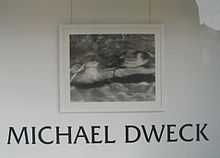
Dweck's second book Mermaids was released in 2008 by Ditch Plains Press. Its photographs featured female nudes swimming under water, evoking the legend of the mermaid. As art editor Christopher Sweet described them in his introduction to the book, “Whether diving in the blue refractions of a swimming pool or suspended like a seraph in the cool, pellucid depths of a spring or emerging tentatively onto a rocky shore, Michael Dweck’s mermaids are lovely and aloof and bare of all raiment but for their beautiful manes and the elemental draperies that surround them. Water, light, and lens converge to capture in modern guise the elusive creature of myth.”[29]
Like his previous book, The End: Montauk, N.Y., Mermaids was inspired by Dweck's experiences interacting with the local environment. While night fishing in the waters off Long Island's south shore, Dweck was captivated by the flashing streaks of light caused by fish swimming beneath him. “The idea was, if I happen to fall overboard one night, what would I see down there? Those flashes of light could be mermaids.”[30] [31] [32] Mermaids continued the focus on attractive young people in water settings which characterized The End, but departed from The End's romantic realism to veer into fantasy, with photographs blurring the lines between reality and imagination.[33]
Unlike The End, Mermaids was shot in and through the water, using methods for underwater flash photography developed by Harold Eugene Edgerton.[34] The technology required to house and protect large format cameras was not yet widely available, leading Dweck to design his own cases for the project, using weights and pulleys to manipulate the camera.[33] To obtain the desired angles for the shots, Dweck used two different techniques, diving into the water with his subjects, either with a long snorkel or unaided, and shooting from behind a glass wall placed within the river. As Dweck explained it:
I just started to experiment. I said to myself, "OK, I have light, I have a lens and I have water"[30]
Rather than use professional models, Dweck turned to women with the experience needed to move comfortably and naturally in underwater environments, including friends from his native Long Island's East End as well as residents of the rural fishing village Aripeka, Florida. Shooting took place both locally in Montauk and Amagansett and in the Weeki Wachee River, where some inhabitants of Aripeka, located on a nearby island in the Gulf of Mexico, had been employed to perform at the Weeki Wachee Springs waterpark while costumed as mermaids.[33] [35] [36][37] According to Christopher Sweet, Dweck met a performer who had been raised in Aripeka and had spent her life in and around water, who then introduced him to other local girls, “some of whom could hold their breath underwater for as long as five or six minutes.”[29]
One gelatin silver print from the collection entitled "Mermaid 1" sold at auction in 2009 at Christie's in London for over $17,000, well over intiial estimates.[38] Photographs from Mermaids were exhibited at galleries in New York, Los Angeles, London, Belgium, Hamburg, and Tokyo, and were featured in Playboy under the title "Sirens' Dance."[39][40]
Habana Libre
Dweck authored a 2011 pictorial book, Habana Libre (Free Havana) about the privileged class in modern Cuba. The book includes rare interviews with the sons of Fidel Castro and of Che Guevara, and it focuses largely on the "creative culture" of Cuba.[41] Other subjects of this book include "artists of the farandula's sophisticated and socially connected circle," such as musicians Francis de Rio and Kelvis Ochoa; painters Rene Francisco, Rachel Valdez and Carlos Quintana; dancer Yaday Ponce Toscano; and novelist Leonardo Padura.[42]
The book was featured in The New York Times, which documents Dweck's eight return visits to the island.[43]
A review in Miami New Times notes that "it's hard to tell if [Dweck is] glamorizing the privilege or slyly exposing the hypocrisy of the myth of communist equality".[44] Highlighting the book, a feature pictorial story, "Elit Küba", appeared in the Turkish magazine Tempo.[45][46] An opinion column in El País noted how the sons of revolutionaries had undeniably broken a tacit pact with their elders, not to give aid to an American documentary of their lives; but perhaps they could not stand the constraint of the political party any longer.[47]
New York's Staley-Wise Gallery opened an exhibit of Dweck's work -- Habana Libre and The End: Montauk, N.Y.—to coincide with the release of the Habana Libre book on December 9, 2011. According to Dweck, both places have "aesthetic" similarities. However, as he discovered, both have much more in common: "Here are two worldly paradises, both built-up in the 50's and preserved since – for better or worse; both populated by insular groups in some kind of isolation, whether it's self or externally imposed; both beset by threats from without and by new hierarchies from within." [48] Dweck's exhibit at Staley-Wise ran through late January 2012.
Starting February 24 and running through March 24, 2012, Dweck was the first American contemporary artist to mount a solo exhibition in Cuba since the US embargo on that country began.[49][50] Dweck also "made history" with a much larger than expected turnout for the February 24 opening as the museum was "expecting 300 or so guests" but instead, when Dweck arrived, he was "greeted by a crowd of about 2,000 Artists, Ambassadors, and Media outside, who weren't allowed in until he got there." [51]
Dweck's exhibit at Fototeca de Cuba showcased images from his book but "presented in greater scale using an unconventional paper and special printing technique that were created especially for the exhibition."[42] Of the added touch in the exhibit, Dweck said, "I've been given the honor of being one of the first living American artists to exhibit in Cuba, I felt I had to present something additional as a show of respect and gratitude. The unique motif is meant to honor the beauty of the island's past, reflect the heat of the people and serves as a reflection of their spirit, their future, their potential."[42]
During the exhibit's opening, Dweck announced a gift of "all 52 photographs to the Fototeca Museum and the Cuban people. The gift's value is estimated around $500,000."[52] That same evening, Alex Castro and Camilo Guevara toured the upstairs exhibit, protected with armed bodyguards. Another of Fidel Castro's sons, Alejandro Castro, later humorously said to Dweck, "Thanks for making me famous."[50]
Surfboards
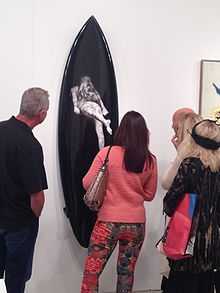
Recently, Dweck has revisited themes from his first two books, The End and Mermaids, to create customized surfboards emblazoned with black-and-white silhouette images of mermaids.[33] Dweck describes himself as a casual surfer, and the boards are ridable as well as works of art.[53] The surfboards measure six feet and six inches in length and are handcrafted in California. They are named after figures who have influenced Dweck's career, such as Harold "Doc" Edgerton, who developed techniques for underwater flash photography used extensively in Mermaids, and Duke Kahanamoku who is widely credited with popularizing the sport of surfing.[34]
One of Dweck's surfboards was auctioned in a benefit for Southampton Hospital[53][54][55]
Blunderbust
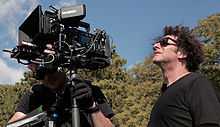
Dweck is currently directing his first 90-minute feature film entitled Blunderbust, which explores and documents the culture of amateur stock car drivers at the Riverhead Raceway in Riverhead, New York and laments the impending destruction of the Raceway, the last of what were once forty on Long Island, at the hands of "big-box" stores.[56][57] Like The End, it builds upon Dweck's attachment to his native Long Island, but with an overtly sociopolitical message not found in previous works. As Dweck states in the synopsis of the film:
On March 5th, the 10,818th Walmart broke ground in the town of Riverhead NY. No big deal, right? You drive along just about any road in America and soon enough you are bound to hit one, and if not a Walmart, it’ll be any of the other big box stores that have come to define 21st century American architecture. Interchangeable concrete boxes with corporate logos tacked on front. They are all the same, and maybe that’s the idea.[58]
Currently in post production, Blunderbust is scheduled for release in 2015.[59] The film's release is to be accompanied by a touring exhibit of physical artworks.[34]
Other works
Snoecks published a series of Dweck's work titled Sex Bombs which features photographs of nuclear and other military missiles.[60] Dweck also produced another project that features oversized Polaroid instant camera pictures, called Giant Polaroids: Pin Up.[61] The Polaroids were taken with a rare Polaroid 20x24 large format camera.
Published works
- The End: Montauk, N.Y., 2004, ISBN 0-8109-5008-1[62][63]
- The Girls of Montauk, 2007, Playboy – (also with model Reby Sky)[64]
- Mermaids, 2008, ISBN 978-0-9818465-0-7[32]
- Habana Libre, 2011, ISBN 978-88-6208-184-9[41]
Noteworthy photographs
- Sonya, Poles – Montauk, NY, 2002. Sold at auction in 2009 at Christie's in London for over $17,000.[21] In March 2010, Dweck filed a copyright infringement lawsuit against a New York based clothing company, accusing them of using his Sonya, Poles photograph in their advertisements without permission.[65][66][67] Another print then sold in 2011 for $30,000.[22]
- Lilla – Napeague Beach, Montauk, NY, 2002. Sold at auction for £2,200.[68]
- Dave and Pam in their Caddy – Montauk, NY, 2002. Sold at auction in 2009 at Christie's in London for over $12,000.[69]
- Mermaid 1 – Amagansett, NY, 2005. Sold at auction in 2009 at Christie's in London for over $17,000.[38]
- Mermaid 18 – Weeki Wachee, FL. Sold at auction in 2011 at Bukowskis in Stockholm for $20,657.[70]
- Surf's Up 1 – Montauk, NY, 2006. Sold at auction in 2009 at Christie's in London for over $32,000, then in 2014 at Phillips for over $46,000.[71][72]
Exhibitions
- July 11 – September 13, 2014: Michael Dweck & Howard Schatz: Underwater, Staley Wise Gallery. New York, NY.[73]
- February 24 – March 24, 2012: Michael Dweck: Habana Libre, Fototeca de Cuba Museum, Havana.
- December 9, 2011 – January 28, 2012: Michael Dweck: The End and Habana Libre, Staley Wise Gallery. New York, NY.
- December 2, 2011 – February 25, 2012: Habana Libre, Blitz Gallery. Tokyo, Japan.
- November 17 – December 8, 2011: Michael Dweck: Island Life, Izzy Gallery. Toronto, Ontario, Canada.
- December 30, 2010 – February 15, 2011: Michael Dweck: Giant Pin-Up Polaroids, Maruani & Noirhomme Gallery. Knokke, Belgium.*September 8 – October 29, 2011: Habana Libre, MODERNISM. San Francisco, CA.
- September 16 – October 25, 2010: American Mermaid, Acte 2 Galerie. Paris, France, in collaboration with Maruani & Noirhomme Gallery.
- June 24 – August 28, 2010: Michael Dweck: Paradise Lost, MODERNISM. San Francisco, CA.
- January 24 – March 14, 2009: Mermaids, Gallery Orchard. Nagoya, Japan.
- October 15 – December 15, 2008: Mermaids, Blitz Gallery. Tokyo, Japan.
- September 19 – November 10, 2008: Mermaids, Robert Morat Galerie. Hamburg, Germany.
- September 13 – October 4, 2008: Michael Dweck: Mermaids, The End, and Flowers, Keszler Gallery. Southampton, NY.
- June 19 – September 1, 2008: Mermaids, Staley Wise Gallery. New York, NY.
- May 15 – September 1, 2008: Mermaids, Delphine Pastor Galery, Monte Carlo, Monaco in collaboration with Maruani & Noirhomme Gallery.
- March 1 – April 20, 2008: Michael Dweck, Maruani & Noirhomme Gallery. Knokke, Belgium.
- November 17 – December 28, 2006: 'A Surfer's Life, Nagoya, Tokyo, Japan.
- May 30 – July 15, 2006: A Surfer's Life, Blitz House. Meguro-ku and Shimomeguro. Tokyo, Japan.
- April 1–29, 2006: A Surfer's Life, Gallery Orchard, Oosu, Naka-Ku, Japan.
- September 30 – November 15, 2005: Three, Aoyama. Tokyo, Japan.
- September 2003: The End: Montauk, NY, Sotheby's. New York, NY.
Awards
- 1998 – Gold Lion – Cannes International Festival for Arctic Ground Squirrel[10][74]
- 2000 – Advertising Excellence – AICP – Work entered into the permanent collection of the Department of Film, Museum of Modern Art, New York.[75]
External links
- MichaelDweck.com, official website
- MichaelDweck.com/blunderbust, official Blunderbust movie website
- Ditch Plains press, publisher of Mermaids
- Habana Libre book, site for Habana Libre
References
- ↑ 1.0 1.1 1.2 1.3 "Michael Dweck on artnet". artnet.com. Retrieved November 12, 2010.
- ↑ "Michael Dweck in artnet Monographs". Artnet.com. Retrieved 2010-11-19.
- ↑ Ignacio Villarreal. "Michael Dweck's American Mermaids Opens at acte2galerie in Paris". Artdaily.com. Retrieved 2010-11-19.
- ↑ "Sothebys, New York, 2003". Michaeldweck.com. Retrieved 2010-11-19.
- ↑ Mead, Julia C. (July 18, 2004). "A Tale of Montauk And Naked Women". New York Times. Retrieved May 13, 2012.
- ↑ Felber, Jaime. "Mermaids: Michael Dweck's Florida & East End Images Celebrate Escapism". Dan's Paper. Manhattan Media LLC. Retrieved May 12, 2012.
- ↑ "Michael Dweck". Staleywise.com. Retrieved 2010-11-19.
- ↑ "Ads about nothing?". CNN Money. April 8, 1998. Retrieved November 12, 2010.
Advertising is the quintessential sitcom," Dweck told the Times. "The love affairs with clients, the breakups, the coming back together again and, of course, the constant reruns.
- ↑ 9.0 9.1 Nudd, Tim (September 6, 1999). "Creative Profile: Comic Bigwig". AdWeek.
- ↑ 10.0 10.1 "Nike skateboarders win Cannes Film Grand Prix – advertising news – Campaign". Campaignlive.co.uk. 1998-06-29. Retrieved 2010-11-19.
- ↑ Riggs, Thomas (2000). Major Marketing Campaigns Annual. Farmington, Michigan: Gale Group. p. 500. ISBN 978-0-7876-3815-3.
- ↑ "The 1999 Boards Awards". Boards Magazine (Brunico Communications). 1999-12-01. Retrieved 2011-01-11.
- ↑ "O'Toole Creative Awards Winners & Finalists" (PDF). American Association of Advertising Agencies. 2008. Retrieved 2011-01-11.
- ↑ "THE MEDIA BUSINESS: ADVERTISING -- ADDENDA; Co-Founder Departs The Dweck Agency". The New York Times. April 29, 1999. Retrieved November 15, 2010.
Ms. Campbell, 36, had been partner and creative director at Dweck & Campbell, which has gained a reputation in the industry for unconventional creative work.
- ↑ "THE MEDIA BUSINESS: ADVERTISING -- ADDENDA; Dweck to Shut Doors After a 9-Year Run". The New York Times. June 29, 2001. Retrieved November 15, 2010.
Dweck in New York, an agency known for producing award-winning, attention-getting campaigns for smaller advertisers, said yesterday that it would close after nine years.
- ↑ "Michael Dweck: Forever Young". Digital Photo Pro. April 10, 2010. Retrieved September 9, 2012.
- ↑ "Michael Dweck in artnet Monographs". Artnet.com. Retrieved 2011-01-02.
- ↑ 18.0 18.1 "BOOKS; A Tale of Montauk And Naked Women – New York Times". Nytimes.com. 2004-07-18. Retrieved 2010-11-19.
- ↑ Mead, Julia C. (2004-12-05). "BOOKS – For This Publisher, the East End Is a Profitable Subject – NYTimes.com". Long Island (NY); Hamptons (NY): New York Times. Retrieved 2010-11-19.
- ↑ "Michael Dweck.". Excelencias Magazines. Retrieved 2011-04-06.
- ↑ 21.0 21.1 "Michael Dweck (b. 1957) Sonya, Poles, Montauk, NY, 2002". Christies.com. Retrieved 2011-04-06.
- ↑ 22.0 22.1 "Lot 76, Michael Dweck, Sonya, Poles, Montauk, NY, 2002". Phillips de Pury. Retrieved 2011-05-11.
- ↑ "The Awards". Esquire Magazine. August 2004. p. 28.
- ↑ "Gallery Orchard, Nagoya, Tokyo, 2006". Michaeldweck.com. Retrieved 2011-01-02.
- ↑ "Michael Dweck; The End: Montauk, N.Y. (essay)". Michaeldweck.com. Retrieved 2011-04-06.
- ↑ "Montauk Look", New York Post, July 3, 2011.
- ↑ "Michael Dweck in artnet Monographs". Artnet.com. Retrieved 2011-01-02.
- ↑ "Three 2006". Michaeldweck.com. Retrieved 2011-01-02.
- ↑ 29.0 29.1 Dweck, Michael (2008). Mermaids. Ditch Plains Press. ISBN 978-0981846507. Retrieved November 18, 2014.
- ↑ 30.0 30.1 Davis, Jennifer (August 8, 2008). "Underwater aspect adds new dimension to nudes". Retrieved May 12, 2012.
- ↑ Estes, Lenora Jane. "Imagining Mermaids". Vanity Fair. Conde Nast. Retrieved May 12, 2012.
- ↑ 32.0 32.1 "Michael Dweck". Artphotoexpo.com. Retrieved 2010-11-19.
- ↑ 33.0 33.1 33.2 33.3 Marin, Kate (July 3, 2014). "Underwater: Michael Dweck and Howard Shatz at Staley-Wise gallery". Musée.
- ↑ 34.0 34.1 34.2 "Michael Dweck wows with reinvisioned works at new gallery show at Staley Wise, New York". Retrieved December 19, 2014.
- ↑ McCombs, Emily. "'Mermaids' Takes Art Underwater". Asylum for all mankind. AOL. Retrieved May 12, 2012.
- ↑ Ignacio Villarreal. "Michael Dweck's American Mermaids Opens at acte2galerie in Paris". Artdaily.com. Retrieved 2011-01-02.
- ↑ Schoeneman, Deborah (January 1, 2008). "Mermaids Past and Present Keep Things Real". New York Times. Retrieved May 12, 2012.
- ↑ 38.0 38.1 "Michael Dweck (b. 1957) Mermaid 1, Amagansett, NY, 2005". Christies.com. Retrieved 2011-01-02.
- ↑ "Sirens' Dance: Underwater, the supernatural beauty of Michael Dweck's mermaids will leave you out of breath". Playboy. Retrieved 2011-01-02.
- ↑ "Michael Dweck – Mermaids (press release)". Ditch Plains Press. Retrieved 2011-01-02.
- ↑ 41.0 41.1 "Habana Libre". Damiani. Retrieved 2011-05-11.
- ↑ 42.0 42.1 42.2 "American Photographer Michael Dweck Reveals the Secret Life of Cuba's Creative Class at an exhibition at Fototeca de Cuba Museum in Havana Cuba". Retrieved 2012-02-11.
- ↑ "What Would Che Say?". The New York Times. 2011-07-27. Retrieved 2011-08-17.
- ↑ "Habana Libre: New Photo Book Shows Fidel and Che's Sons Living in Luxury in Cuba". Miami New Times. 2011-07-27. Retrieved 2011-08-17.
- ↑ Sogukdere, Ozlem (August 2011). "Elit Küba". Tempo (Dogan Media Group): 118–125. Retrieved 2011-09-13.
- ↑ "ELİT KÜBA". Milliyet. 2011-09-08. Retrieved 2011-09-13.
- ↑ "En el árbol dinástico de la revolución". El País. 2011-09-05. Retrieved 2011-09-13.
- ↑ "Staley-Wise Gallery presents exhibition of works from famed photographer Michael Dweck". 2011-12-08. Retrieved 2011-12-17.
- ↑ Schonberger, Nick. "American Photographer Michael Dweck Reveals Secret Life Of Cuba's Creatives". Complex.com. Retrieved March 11, 2012.
- ↑ 50.0 50.1 Parshley, Lois. "Splendor Amid Poverty: Gallery nights with Cuba's gilded elite". The Atlantic. Retrieved September 9, 2012.
- ↑ "American Photographer Michael Dweck Makes History in Cuba". 2012-03-01. Retrieved 2012-03-10.
- ↑ "American Photographer Michael Dweck Makes History in Cuba". 2012-03-01. Retrieved 2012-03-04.
- ↑ 53.0 53.1 Peterson, Holly (July 2014). "How 8 Artful Surfboards Give Back". Hamptons Magazine (Southampton, New York: Debra Halpert). Retrieved December 19, 2014.
- ↑ "Hamptons magazine to auction $75K artist surfboard for local charities".
- ↑ "A Michael Dweck Surfboard & Portrait Plus Lunch in Montauk with Michael Dweck & Publisher Debra Halpert". Retrieved December 25, 2014.
- ↑ Sammon, Will (September 6, 2013). "Michael Dweck's love of Riverhead's racetrack will be shown in film". Newsday.
- ↑ Dweck, Michael. "Blunderbust".
- ↑ "Synopsis for Blunderbust (2015)". Retrieved 25 December 2014.
- ↑ "Blunderbust".
- ↑ "Michael Dweck – Snoecks 2011". Snoecks.com. Retrieved 2011-01-02.
- ↑ "Michael Dweck Catalogue". Artnet.com. Retrieved 2011-01-02.
- ↑ MEAD, JULIA C. (2004-07-18). "BOOKS; A Tale of Montauk And Naked Women". The New York Times. Retrieved 2010-11-17.
At once nostalgic and cunningly commercial, The End purports to reminisce about all that Montauk has lost since the 1970s when Mr. Dweck, who lives in Glen Cove, first found it.
- ↑ "The End: Montauk, N.Y. 2004". Michaeldweck.com. Retrieved 2010-11-19.
- ↑ http://www.danshamptons.com/content/danspapers/issue07_2007/15.html
- ↑ "Photog sues Malibu Denim over purloined pic". New York Post. March 23, 2002. Retrieved November 12, 2010.
- ↑ "Lawsuit Summary – Michael Dweck v. Diana Amadi et al". rfcexpress.com. March 24, 2010. Retrieved November 12, 2010.
- ↑ "Dweck v. Amadi et al :: Justia Dockets & Filings". justia.com. March 22, 2002. Retrieved November 12, 2010.
- ↑ "MICHAEL DWECK, Lilla, Napeague, Montauk, New York". LiveAuctioneers.com. Retrieved 2011-03-26.
- ↑ "Michael Dweck (b. 1957) Dave and Pam in their Caddy, Montauk, NY, 2002". Christies.com. Retrieved 2011-03-26.
- ↑ "Michael Dweck (American, b. 1957)". Michael Dweck. Artinfo. Retrieved March 11, 2012.
- ↑ "Michael Dweck (b. 1957) Surf's Up, Montauk, NY, 2006". Christies.com. Retrieved 2011-03-26.
- ↑ "208 ULTIMATE CONTEMPORARY MICHAEL DWECK Surf's Up 1, Montauk, NY, 2006". Phillips.com. November 18, 2014. Retrieved December 24, 2014.
- ↑ "Underwater; Michael Dweck & Howard Schatz". Retrieved December 25, 2014.
- ↑ "Goodby Wins TV Grand Prix". Adweekmedia.com. 1998-06-29. Retrieved 2010-11-19.
- ↑ "Michael Dweck list on artnet". artnet.com. Retrieved November 14, 2010.
|